Re-enactment, Archaeology, and the Ancient Rome & Greece Weekend IV of IV: The Tunic
Published
Categories
Author
Blog Post
An important part of everyday life in the past, but one with very little impact on the archaeological record, is clothing. Hence clothing is obviously an important part of my attempt to recreate the equipment of a soldier from 3rd century Dura-Europos. People typically wore clothes in the past, but unfortunately it was normally made of materials which are subject to rot, so we have much less evidence than we do of say, pottery. However evidence still exists, including the painting of Julius Terentius from the Temple of the Palmyrene Gods in Dura-Europos. The Terentius painting shows men wearing white tunics with purplish/reddish decoration, dark leggings, and a white or reddish/brownish cloak pinned at the right shoulder.
Tunics of a similar nature are also found in the archaeological record. Thirty-six fragments from Dura-Europos are thought to be from tunics, all are of wool, of these two are complete enough to give a length of the garment, one is a child's, so that leaves one adult tunic and this has a garment-length of 92.0 cm. The ROM has 246 tunics or tunic fragments of the Late Roman to Byzantine periods from Egypt, of which 27 are sufficiently complete to be reconstructed (I would like to thank the ROM's Anu Liivandi for this information). A number of them are attributed to al-Fayyum or Akhmim, and were acquired by Charles Currelly in the early 20th century. Overwhelmingly they are made of undyed (and so white) linen tabby (simple plain-weave) with decoration in coloured wool predominantly tapestry-woven into the linen, or in some cases sewn onto the linen tunic.
One of the more complete tunics is very like the tunics worn by Terrentius and his men (accession number 910.1.2), and was found at Akhmim. It was published by Dorothy Burnham in "Cut my Cote" in 1973, and her drawing of the pattern is shown below. The garment has a length of 126 cm, rather longer than the one Dura-Europos tunic, but typical for Egypt, or which there are many more examples in the ROM and elsewhere. It was woven in one piece, sideways, and so its length is determined by the width of the loom. This is typical for tunics of this period, and if the tunic is too long it is taken up by being folded in the centre, around the waist. Tunic #910.1.2 has traces of where it was sewn together, although no part was cut out, other examples were cut around the waist and then sewn together. Not cutting it would mean it could be let out again. The garment would not be taken up at the bottom as it would mean finishing the edge of the textile, and the waistline would be covered by a waist-sash or belt anyway. I chose to recreate an Egyptian tunic partly because we have a lot more evidence for Egyptian tunics (it is conceivable that the one Dura-Europos tunic is unusually short), partly because it is a ROM object, and also partly because wearing linen is probably preferable to wearing wool in the ROM in July!
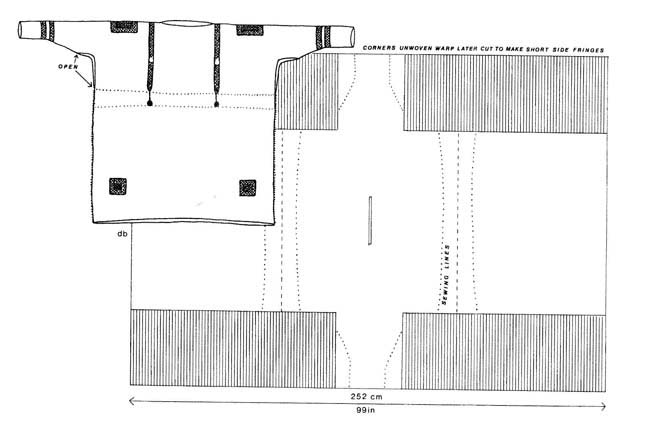
The pattern from the ROM's tunic #910.1.2, as published in Dorothy Burnham's "Cut my Cote". Note where the grament was "taken up" by having a fold sewn up around the waist. Note also that because it was woven as a single piece on the loom it would be the size of the loom, and would probably not be tailored to fit an individual. This is part of the rational of seeing if is possible to have a long tunic like we find in the archaeological record look like a short tunic on a soldier as we see them in depictions.
I asked Gwen Nowrick of Black Swan Designs (Historic Enterprises) to make a copy of tunic 910.1.2 using Burnham's pattern. I had already worked with Gwen to make reproductions of mediaeval clothes, which is her more typical occupation, but it was a project that interested her. She could not make it in the same way precisely, because it was not possible to get such a large piece of fabric. Also, the coloured details of the original were sewn on, as being tapestry woven would be incredibly expensive. It was, however, to be made of the same linen plain-weave. Although the original is described as having "purple" decoration, true Tyrian purple is very expensive and uncommon, and while the colours in the fabric itself may change with time, the images found on contemporary mummy portraits typical show red bands on the tunic (like the one above). So I asked Gwen to make red decoration.
On first fitting, it is clearly very long, much longer than Terrentius' tunic. But could it be made to be similar? I first tried to just put the belt on and fold everything under it, but this really did not work. But then I tried tying a sash around my waist. This is actually a common depiction of the time, from other wall-paintings at Dura-Europos for instance with depictions of civilians. I then pulled the tunic up so it had the right length, and draped the fabric over the sash. This, again, is a style often depicted, such as of hunters or other active but possibly civilian pastimes. It was then easy to put the belt over the fold, as it would typically be soldiers that wore the belt, a sign of their status as a soldier. This created a profile rather like Terrentius, and even more like some of his men, that seem to wear more than one belt.
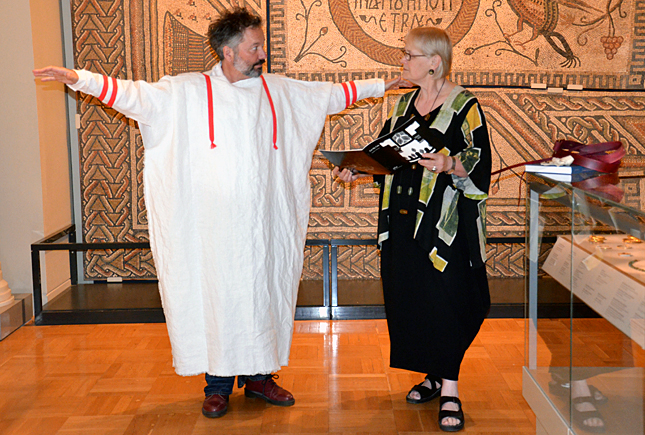
Here I am in the un-belted tunic with Costume and Textiles curator Anu Liivandi trying to not look like we are recreating a scene from "Lawrence of Arabia." In this form it is very like the ghalabiyya as worn to this day in the Middle East - photo by Kay Sunahara. .
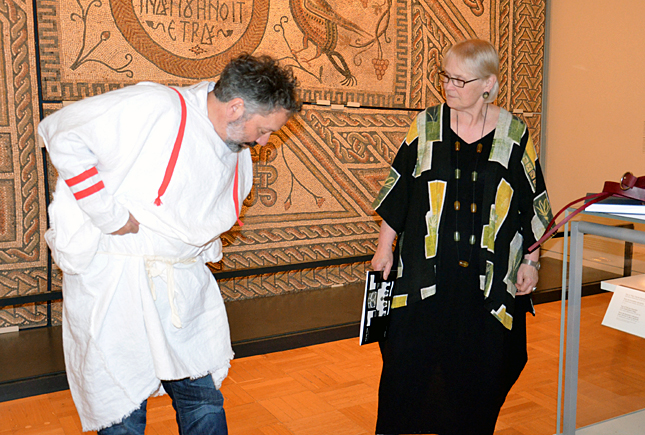
Tying a sash around my waist makes it look very much like how longer tunics were typically worn by civilians in the 3rd century, and then pulling the tunic up to hang over the sash is how it typically looked when civilians were being active - photo by Kay Sunahara.
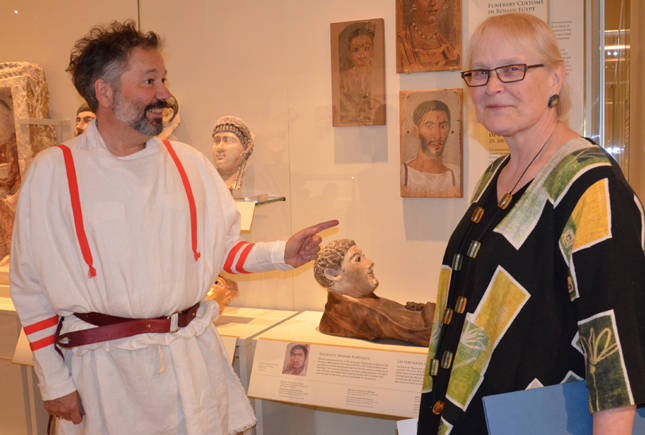
So over the fold goes the military belt, which now looks rather like Julis Terrentius, or at least like some of his men. Here I am pointing out to Anu how much it resembles the mummy portrait - photo by Kay Sunahara.
So possibly all tunics of the period were of this length, but the soldiers wore theirs folded up under the belt? Well, that is how I will be wearing the copy of tunic 910.1.2 on Saturday 15th June on Ancient Rome and Greece Weekend, so come and see how it looks for yourself! It certainly makes a lot of sense that the soldiers are essentially wearing the same long tunic that the civilians are, and it would probably be very comfortable for the soldiers to take off their belts in the evening and relax in a long tunic!
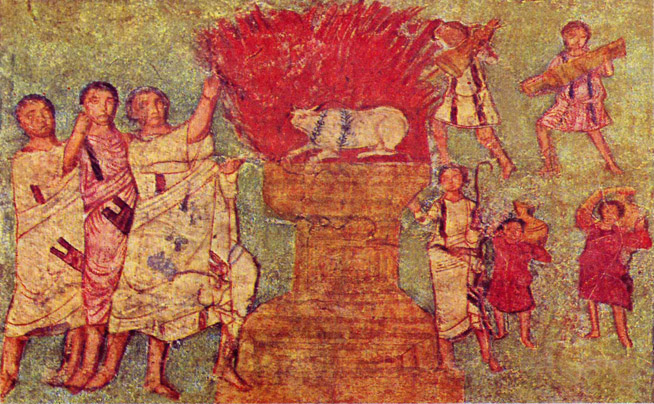
This image is from the wall-paintings in the synagogue at Dura-Europos and shows men in civilian dress rather like the tunic, worn long but possibly belted by the men on the left, but hitched up under the belt by the "active" men in the top right - image from Wiki Commons.


